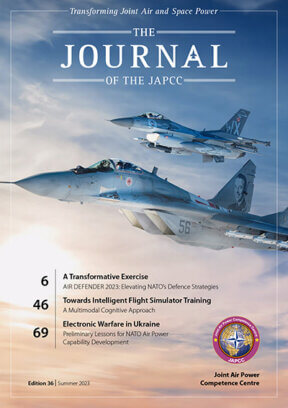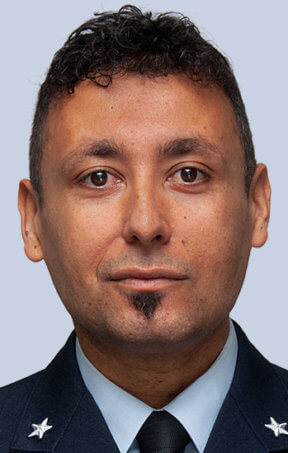‘Obtaining additional air transport mobility – and obtaining it now – will better assure the ability of our conventional forces to respond, with discrimination and speed, to any problem at any spot on the globe at a moment’s notice.’
President John F. Kennedy1
Introduction
NATO’s Rapid Air Mobility (RAM) initiative enables state aircraft to support the rapid deployment of forces during emergent operations. Executing the mobility mission faster, with little or no notice, leads to a more efficient Alliance. NATO Assistant Secretary General for Defence Investment, Mr Camille Grand, stated that ‘by facilitating quicker air movements across the Alliance, we can be more effective in preventing crises, more efficient in deploying our forces, and quicker in reacting when unforeseen situations arise’.2 In addition to contributing to NATO nations’ global reach, RAM is a key enabler for air and space superiority, precision engagement, and agile combat support.
The RAM initiative fills a critical need by supporting the Alliance’s deterrence and warfighting capabilities that rely on quick strategic movement. RAM is not just an Air Component force multiplier but also a crucial enabler of joint and multi-domain operations. This article provides background on the origins of RAM, explains its workings and technical requirements, evaluates the importance and deficiencies of RAM, and provides some recommendations for improvement.
The Origins of RAM
The NATO RAM concept began to take shape in the late 1990s and early 2000s, as NATO members recognized the need for a more flexible and responsive air mobility capability. In 2003, NATO established the Strategic Airlift Interim Solution (SALIS), which provided participating countries access to a fleet of C-17 transport aircraft. This was a significant step towards the development of the RAM capability. In 2004, NATO established the NATO Response Force (NRF), which included a RAM component responsible for providing rapid air transportation of personnel and equipment to crisis areas.
RAM allows NATO aircraft to deploy quickly and with little notice across the Alliance. Activating RAM assigns a distinctive and recognized priority to designated aircraft, facilitating fast routing compared to a standard mobility mission. This allows for swift and efficient movement of personnel and cargo across NATO’s borders and through international and partner airspace. Moreover, it provides Alliance leaders the capability to project hard and soft power at any moment at any location. RAM mission areas include inter and intra-theatre airlift, air-to-air refuelling, aeromedical evacuation, and operational/executive support. RAM has gained importance for many reasons, and allies have quickly realized its significance. The initial operational capability of NATO’s RAM initiative was declared shortly after the 2018 NATO Brussels Summit.
Operational control of RAM resides with Supreme Headquarters Allied Powers Europe (SHAPE). It can be activated in support of crisis management or whenever designated in other situations that require intervention. The Joint Support and Enabling Command (JSEC), directly subordinated to SHAPE, oversees and plans the manoeuvres of the allies.3 Once RAM is activated, dedicated aircraft are assigned the ‘OAN’ call sign, which also includes expedited diplomatic clearances. The European Air Traffic system recognizes the OAN call sign as a priority aircraft, lifting military airspace restrictions and ensuring a quicker execution through coordination with the relevant air traffic controllers along the flight path. NATO has worked closely with all allies and the European Organization for the Safety of Air Navigation, commonly known as EUROCONTROL, to ensure the procedure is secure and efficient. To summarize, OAN-designated aircraft get preferred access over all other traffic in European airspace. Besides procedural provisions, RAM must also account for a series of technical requirements.
Technical Requirements
Many nations within the Alliance place greater emphasis on technology while paying reduced attention to the other two aspects of the military employment revolution: operational and organizational changes. The correct use of technology to enhance a force’s capabilities and the fact that it takes time to adapt are two important lessons learned from military history. This is also true for the implementation of RAM: it requires operational and organizational changes together with technological advancement.
In order to have a substantial impact, technological advancements typically necessitate concurrent modifications in doctrine, equipment, force composition, tactics, organization, and command and control. In other words, if organizational and operational changes are not made, technology on its own will have limited, if any, positive effects. This also has implications for the introduction and use of RAM.
Global Air Traffic Management (GATM), which includes communications, navigation, surveillance, and air traffic management, gives EUROCONTROL sufficient surveillance and control of air traffic to safely and efficiently prioritize military aircraft, which was not previously possible. A number of systems are required to facilitate GATM. Communications are accomplished mostly via datalink, enabling aircrew to request and approve non-verbal clearances and Air Traffic Control (ATC) instructions, gather weather information, and furnish automated position reports. GATM also includes advanced Global Positioning System (GPS) capability for flight navigation in all oceanic airspace thus increasing the accuracy of position data reported to ATC and enabling closer sequencing of aircraft. An active surveillance capability transmits and receives aircraft position and intent data by means of Mode-S transponders and the Traffic Collision Avoidance System (TCAS). Finally, enhanced air traffic management enables Reduced Vertical Separation Minimum (RVSM), which reduces aircraft separation from 2,000 to 1,000 ft vertically.
Compliance with these technical requirements enables aircraft to use the most direct air routes between destinations without incurring time and fuel-consuming deviations around restricted airspace. To guarantee access to optimal European airspace for all air mobility aircraft, it is fundamental to comply with RAM requirements as soon as possible, either by investing in new technology or by making the most of the existing platform by carrying out operational and organizational changes. Without RVSM and TCAS, an aircraft cannot participate in RAM operations.
The Growing Importance of RAM
We are witnessing a profound and constant information evolution, which accelerates conflict escalation, driving the requirement for military forces to respond extremely quickly.4 Furthermore, the constant evolution brought by globalization and changing supply chains requires extra effort from military logistics.
Air Mobility is an essential component of all three elements of NATO’s capacity to enhance security abroad: shaping the international environment, responding to crises, and preparing for an uncertain future.5 Deployments and exercises both require air mobility, in the form of airlift, to transport the required personnel and equipment, and air refuelling. Other activities, such as aeromedical evacuation, are vital in responding to threats and emergencies by strengthening the warfighting capability. Coalition members may need to deploy forces into a theatre of operations quickly or move forces closer to a crisis area.
Both foreign or forward presence and involvement during times of tension need the delivery of supplies and equipment to happen in hours or days as opposed to weeks, a mission particularly well suited for air mobility. At the onset of a crisis, forces may deploy at a smaller scale to accomplish humanitarian assistance, enforcement of no-fly zones, non-combatants evacuations, allies’ reinforcement, limited strikes, and military interventions.
Some nations have pursued a version of lean logistics, typically referred to as ‘just-in-time logistics’. This was evident during Operations Desert Express, European Express, and Bosnia Shuttle when the aim was to minimize inventory and reduce costs. The closure of depots resulted in an increased reliance on air mobility forces, primarily on airlifters and, to some extent, tankers, to support forward deployed forces and deliver essential and frequently life-sustaining services.
In 2020, allied nations used the RAM initiative to support relief planes transporting critical supplies for the pandemic fighting effort. Another example of RAM activation took place in August 2021 as part of Operation Allied Solace, at the conclusion of NATO’s Resolute Support Mission in Afghanistan, facilitating the emergency relocation of NATO-affiliated Afghans and their families.6 Over the last four years NATO RAM has advanced rapidly but is there room for improvement?
Weaknesses and Obstacles
Several reasons have prevented the use of this key enabler, and one is timing. To be efficient and effective, the RAM process needs to run smoother, more specifically the time from the initial RAM request through SHAPE to execution sometimes takes too long compared with the existing procedures, and thus is unable to meet the delivery date. Additionally, some nations have already signed bilateral agreements with most of the NATO countries or have ad-hoc procedures in place. This ensures that diplomatic clearances are received quickly, often in less than 72 hours, which is less or similar to the RAM process.
For some countries, RAM does not provide much benefit because the standing national system is incompatible with the RAM system used to produce diplomatic clearances and cargo loads. However, more importantly, RAM flights can only be used for narrowly defined purposes, such as missions in direct support of the Very High Readiness Joint Task Force (VJTF).7
To summarize, the benefits of using RAM have to increase. Regulations should be more permissive regarding the type of cargo allowed to transport. Furthermore, the SHAPE activation process must be more expeditious to make RAM more relevant.
Conclusions and Recommendations
The air mobility enterprise must increase its responsiveness and flexibility to further integrate into NATO’s future operations. Moreover, the air mobility operating environment is dynamic: airspace and airfield access can be restricted by continuously changing factors such as weather conditions, airspace closures, or threats. RAM helps break through those barriers by prioritizing NATO air missions and enabling aircraft to accept rapid re-tasking and even mid-mission re-planning. It can also receive new diplomatic clearances while en-route to include alternate destinations. The future air mobility fleet should be prepared to operate in the full spectrum of future environments to avail of the speed and agility air mobility currently provides to the joint warfighter.
When assessing the current RAM situation, there is evident room for improvement. It would be ideal for RAM to see support in a top-down approach to create a common and broad understanding and ensure implementation. Unfortunately, RAM is not yet matched by operational confidence and efficiency. Too often national processes and procedures are preferred, even by nations that clearly understand RAM’s benefits. The following recommendations should be considered to improve and further the adoption of RAM:
- Streamline the staffing process at SHAPE in order to make air mobility truly more rapid.
- Re-evaluate cargo restrictions. Nations should be allowed some flexibility in planning their limited air transport assets.
- Incorporate the technical requirements needed for RAM in all NATO air transport aircraft.
- Encourage and advocate the activation of RAM as a key tool to provide political value by showing the Alliance Unity of Effort.
- Promote RAM at national and international levels, to reach all civil and military stakeholders.
- Ensure the required exercising and training opportunities are available through continued consideration and representation in the NATO Education, Training, Exercises, and Evaluation process.
In order to satisfy the demands of present and future missions, the Alliance needs mobility forces that are ready and capable of operating in the future environment. In a world running fast, NATO has to run faster to be on top.












